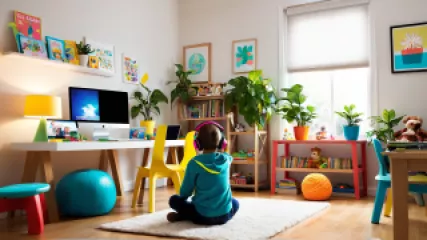How to Use Virtual Therapy for Kids in Child Psychology
Child psychology is a multifaceted field that addresses the mental, emotional, and behavioral development of children. With the advent of technology, virtual therapy has become an increasingly popular option for addressing these needs. This article will serve as a comprehensive guide on how to effectively use virtual therapy for kids within the realm of child psychology.
Understanding Virtual Therapy for Kids
Virtual therapy, also known as online therapy, is the practice of providing psychological support and treatment through digital platforms. It can be particularly beneficial for children and adolescents, offering a flexible and accessible way to receive care.
The Basics of Online Therapy for Children
Online therapy for children involves using video calls, chats, and other digital communication methods to provide therapeutic support. This form of therapy can include various approaches such as cognitive behavior therapy for kids, play therapy, and family counseling. The goal is to offer a safe, comfortable, and effective way for children to express their feelings and work through challenges.
Benefits of Virtual Therapy for Kids
- Accessibility: Children in remote or underserved areas can access quality mental health care.
- Flexibility: Sessions can be scheduled at convenient times, reducing the need for travel.
- Comfort: Being in a familiar environment can make children feel more at ease.
- Continuity: Therapy can continue even if the family moves or circumstances change.
Challenges to Consider
- Technical Issues: Internet connectivity and technological glitches can disrupt sessions.
- Engagement: Keeping younger children engaged through a screen can be challenging.
- Privacy: Ensuring confidentiality in a non-clinical setting requires careful planning.
Setting Up for Success
Before starting virtual therapy, it’s crucial to prepare both the child and the environment. Here's how:
Preparing the Child
Children need to understand what to expect from virtual therapy. Explain to them in simple terms what the process will involve and answer any questions they might have.
- Discuss the role of the therapist and what kinds of activities they might do together.
- Reassure them about the safety and confidentiality of the sessions.
- Address any concerns they have about using technology.
Creating an Optimal Environment
The environment in which the child participates in therapy can significantly impact the effectiveness of the sessions.
- Quiet Space: Ensure the area is free from distractions and noise.
- Comfort: Make sure the child has a comfortable chair and setup.
- Privacy: Ensure that the space allows for confidential conversations.
- Technical Setup: Test the internet connection and equipment beforehand.
Choosing the Right Therapist
Finding a qualified therapist who is experienced in adolescent therapy online and working with children is essential.
Qualifications to Look For
When choosing a therapist, consider the following qualifications:
- Licensing: Ensure the therapist is licensed to practice in your state or country.
- Specialization: Look for therapists who specialize in child psychology and online therapy.
- Experience: Check their experience in dealing with issues similar to your child's.
Initial Consultation
Most therapists offer an initial consultation to determine if they are a good fit for your child. Use this opportunity to ask questions and assess their approach.
- Inquire about their methods and techniques.
- Discuss your child's needs and goals for therapy.
- Evaluate their comfort level with technology and online sessions.
Types of Therapy Available Virtually
There are several types of therapy available virtually, each catering to different needs and preferences.
Cognitive Behavior Therapy (CBT)
Cognitive behavior therapy for kids focuses on identifying and changing negative thought patterns and behaviors. It is highly effective for anxiety, depression, and behavioral issues.
- Structure: CBT sessions are usually structured and goal-oriented.
- Techniques: Techniques include cognitive restructuring, exposure therapy, and skill-building exercises.
- Homework: Children may be given tasks to complete between sessions.
Play Therapy
Play therapy uses play as a medium for children to express emotions and resolve issues. It is particularly effective for younger children who may not have the verbal skills to articulate their feelings.
- Tools: Therapists use toys, games, and creative activities.
- Environment: Creating a playful and engaging virtual environment is crucial.
- Expression: Play allows children to express themselves in a non-threatening way.
Family Therapy
Family therapy involves working with the child and their family members to address systemic issues and improve communication and relationships.
- Participation: Sessions often include parents and siblings.
- Focus: The focus is on improving family dynamics and support structures.
- Collaboration: Encourages collaborative problem-solving and understanding.
Maximizing the Effectiveness of Virtual Therapy
To get the most out of virtual therapy, both parents and children must be actively involved and committed to the process.
Parental Involvement
Parents play a critical role in supporting their child's therapy.
- Engagement: Stay involved in the therapy process by attending sessions when appropriate.
- Support: Provide emotional and practical support to your child.
- Follow-Up: Reinforce the skills and strategies learned in therapy at home.
Consistency
Regular and consistent sessions are vital for progress. Make sure to schedule sessions at regular intervals and stick to them.
- Set a routine that the child can rely on.
- Avoid canceling or rescheduling sessions unless absolutely necessary.
- Track progress and celebrate milestones achieved during therapy.
Overcoming Common Obstacles
Virtual therapy comes with its own set of challenges, but with the right strategies, these can be effectively managed.
Technical Difficulties
Technical issues are one of the most common obstacles in virtual therapy.
- Preparation: Test your internet connection and devices before each session.
- Backup Plans: Have a backup plan in case of technical failures, such as using a phone call instead.
- Patience: Be patient and flexible when technical issues arise.
Maintaining Engagement
Keeping children engaged during virtual sessions can be challenging but is essential for effective therapy.
- Interactive Activities: Use interactive tools and activities to maintain interest.
- Breaks: Allow for short breaks if the child becomes restless.
- Personalization: Tailor sessions to the child’s interests and preferences.
Case Study: Levi Hill's Journey with Virtual Therapy
Levi Hill, a 10-year-old boy, struggled with anxiety and social withdrawal. His parents decided to try virtual therapy for kids to help him manage his symptoms.
Initial Assessment
During the initial assessment, the therapist conducted a thorough evaluation to understand Levi's needs and challenges. They discussed:
- Levi’s background and family history.
- His specific symptoms and triggers.
- Goals for therapy and expected outcomes.
Therapeutic Approach
The therapist decided to use a combination of cognitive behavior therapy for kids and play therapy to address Levi’s anxiety.
- CBT Techniques: Cognitive restructuring and relaxation exercises.
- Play Therapy: Engaging activities to help Levi express his feelings.
- Parental Involvement: Including Levi’s parents in some sessions to provide support.
Progress and Outcomes
Over six months, Levi showed significant improvement in managing his anxiety. He became more confident in social situations and developed coping strategies to handle stressful moments.
- Decreased frequency of anxiety attacks.
- Improved social interactions at school and with peers.
- Enhanced communication skills with family members.
Future Trends in Virtual Therapy
The field of virtual therapy is continuously evolving, with new technologies and approaches emerging to enhance its effectiveness.
Innovations in Technology
Advancements in technology are making virtual therapy more accessible and interactive.
- AI and Machine Learning: Providing more personalized and adaptive therapy experiences.
- Virtual Reality: Offering immersive environments for therapeutic activities.
- Mobile Apps: Facilitating continuous support and monitoring outside of sessions.
Integration with Schools
Integrating virtual therapy into school systems can provide additional support for children.
- On-site virtual therapy sessions during school hours.
- Collaboration between therapists and educators.
- Support groups and workshops for students.
Conclusion
Virtual therapy offers a valuable tool for addressing the mental well-being of children and adolescents. By understanding its benefits, preparing adequately, choosing the right therapist, and staying actively involved, parents can ensure that their children receive the best possible care.
As technology continues to advance, the potential for online therapy for children will only grow, providing even more opportunities for effective and accessible mental health support.
Remember, the key to successful virtual therapy lies in creating a supportive and conducive environment, maintaining consistency, and being open to innovative approaches that cater to the unique needs of each child.






